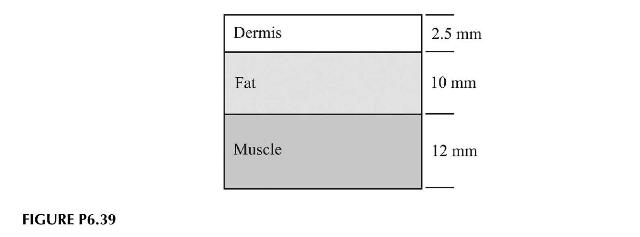There is no physiological difference between a burn caused by scalding (boiling water) and a burn caused
Question:
There is no physiological difference between a burn caused by scalding (boiling water) and a burn caused by dry ice or liquid nitrogen. We are interested in the time required to cause irreparable skin damage in a burn requiring a skin graft. Assume the skin is exposed to boiling water, since there is more data for this case. Irreparable damage will occur if the dermis is exposed to a temperature of \(70^{\circ} \mathrm{C}\) at its base, \(2.5 \mathrm{~mm}\) down from the surface, for \(10 \mathrm{~s}\) (Figure P.39). Assume the skin is at \(35^{\circ} \mathrm{C}\) initially and its thermophysical properties are: \(k=0.2 \mathrm{~W} / \mathrm{m} \mathrm{K}, ho C_{p}=2.5 \times 10^{6} \mathrm{~J} / \mathrm{m}^{3} \mathrm{~K}\).
a. How long will it take to irreversibly burn skin using boiling water?
b. What is the total amount of heat delivered to the skin during this time period?
c. Burns are related to heat being dumped in or removed from the skin. Based on your calculations to part (b), how long would it take to incur a similar burn if the burn were caused by dry ice at \(-78^{\circ} \mathrm{C}\) ? The total heat transferred in a certain time is:
\[q_{s}(0, t)=\frac{k\left(T_{s}-T_{i}\right)}{\sqrt{\pi \alpha t}} A_{s}\]
Step by Step Answer:






